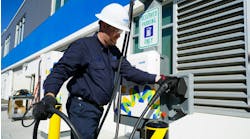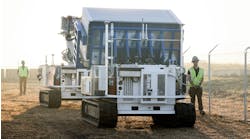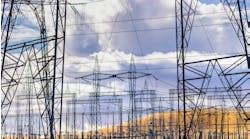Replacing many older aircraft ground servicing electrical systems, solid-state frequency inverters (SSFI) are primarily being used these days as a cost-savings initiative. Because the older systems were based upon a central rotating frequency changer (motor-generator) that operated 24/7, the energy and maintenance costs have become excessive. Point-of-use frequency inverters have lower operating and maintenance costs as they are energized only when needed.
Point-of-use SSFIs are intended to be installed as a permanent part of the facility power distribution and wiring system. The facility power system provides the input to the SSFI where it is rectified to direct current (DC), and through oscillator-referenced solid-state switching components, inverted into a new frequency, namely 400 Hz. A flexible, special-purpose power cable attached to the aircraft power distribution system feeds this 400-Hz power to the aircraft using a unique plug-and-socket arrangement. The cable may be configured with single or multiple conductors for each phase and the neutral. In all configurations, it has two interlock conductors as a safety measure that prevents the cable from being energized until the connector is sufficiently seated in the aircraft receptacle. It does not contain an equipment grounding conductor (Photo).
Source characteristics. Aircraft ground servicing power is identical to that provided by the aircraft generators — a 115/200V, 3-phase, 4-wire, wye-connected electrical system. According to the “400-Hz Fixed Power Systems Design Guidebook,” the system “should be grounded at some point; to a metal underground water pipe, or the metal reinforcing bars of a building, or the grid system of the airport ramp. The grounding electrode conductor must not be any smaller than one-half the cross-sectional area of a phase conductor.”
Because SSFI units commonly contain an output line contactor as well as overcurrent protection, they also serve as the service disconnect. Military Standard 704E, Revision E, 1991, defines the electrical system as a “single-phase or 3-phase wye-connected grounded neutral system having a nominal voltage of 115/200V.” Therefore, it's clear that the installation of such a system must be treated as a derived electrical system.
Because the required output must be in a “grounded wye” configuration, the NEC grounding requirements for derived electrical services must be followed. As per 250.4(A)(1), “Electrical systems that are grounded shall be connected to earth in a manner that will limit the voltage imposed by lightning, line surges, or unintentional contact with higher-voltage lines and that will stabilize the voltage to earth during normal operation.”
Failure to properly ground the neutral conductor is an NEC and OSHA violation. As per 29 CFR Part 1910, Subpart S — Electrical, 1910.304(f)(3)(i), “For a grounded system, a grounding electrode conductor shall be used to connect both the equipment grounding conductor and the grounded circuit conductor to the grounding electrode. Both the equipment grounding conductor and the grounding electrode conductor shall be connected to the grounded circuit conductor on the supply side of the service disconnecting means, or on the supply side of the system disconnecting means or overcurrent devices if the system is separately derived.” Unfortunately, the aircraft service cable does not contain an equipment grounding conductor.
For example, recent noise voltage measurements on a 180kVA frequency inverter found to be missing the system bonding jumper resulted in maximum and minimum voltage measurements of +17.2V and -19.9V. On another poorly bonded system, these measurements yielded a maximum voltage (peak) reading of +3.61V and a minimum reading of -4.36V. After the bonding jumper and fittings on this second system were replaced, the maximum voltage (peak) reading dropped to +0.31V, and the minimum reading dropped to -0.18V.
Load characteristics. Electrically speaking, there is little difference between steel hulled ships, metal frame manufactured housing, and today's modern aircraft. All have electrically conductive skins or frames; the difference being the medium in which each travels. Each can contain any mixture of electrical machinery and complex electronics. However, apparently as a weight-saving practice, only the aircraft, with its grounded wye electrical system is allowed to permit load current flow on the metallic structure. In fact, it is common practice to provide single phase, 115V, 400-Hz electrical power to any conceivable load using a single conductor, the return current thus flowing across the structure. Both commercial and military aircraft generally use the structure both as a ground plane and as a neutral conductor.
Commercial aviation in the United States uses a bonding cable only when fueling with the cable connected to the fueling source as opposed to an earth ground. An earthing connection is not used when the aircraft is at a boarding gate or otherwise receiving ground power from a frequency inverter.
The risk of electromagnetic interference (EMI) damage from excessive common-mode electrical noise is clearly stated in IEEE-Std 1100, Section 4.4.5, as having three distinct types of occurrences: Type I, signal-data disruption; Type II, gradual hardware stress and latent failure; and Type III, immediate hardware destruction.
A Type I, signal-data disruption occurrence, for example, could happen when a keypad data entry (as part of preflight preparations) is corrupted by noise, such that part of the binary data group is forced to an incorrect value. Unless the input is checked for validity, or the word is transmitted multiple times, an improper flight data signal could be transmitted as an input to flight control electronics systems.
An example of Type II gradual hardware stress and latent failure could be a failure that seems to indicate faulty software, but is in fact marginalized operation of solid-state data devices, damaged by EMI but still attempting to function normally. It would be very difficult to determine the difference.
An example of Type III, immediate hardware destruction, would be an avionics device not answering a data bus poll, thus requiring an equipment change. Such damage to solid-state devices can be detected by inspection of failed units using micro-photography. Substrate metal migration is known to form with as little as 5V of noise, thus leaving an indelible signature that may not necessarily be reduced by post incident fire or impact.
The system. Good engineering requires that load characteristics, including any unusual peculiarities, be carefully considered during the design and installation process of new electrical services. The sketches attempt to illustrate individual cases that should be considered. Above all, you must remember that, unlike all other electrical systems, aircraft systems are prone to use the structure (skin and/or airframe) as a current-carrying conductor. This places special emphasis on proper installation and monitoring of premises voltage system sources.
Figure 1 (click here to see Fig. 1) shows a typical aviation installation in which a static bonding cable is not required. This case has the highest possibility of inducing common-mode electrical noise resulting from an improper system bond into the mission avionics as it can develop relatively high common-mode voltages.
Figure 2 (click here to see Fig. 2) shows a typical installation in which a static bond strap is required. Use of the static bond cable reduces common-mode noise by referencing the aircraft structure to earth ground, but provides a current path for neutral currents. Such currents will circulate in a facility as long as the service flex cable is attached to the aircraft — whether or not ground power is applied.
Figure 3 (click here to see Fig. 3) shows the same scenario as Fig. 2 with the addition of a ground-fault sensor. This is a simple means of monitoring static ground cable current. The function of the fault sensor is to monitor the resulting net current difference and ensure that if pre-set limits are exceeded, an automatic shutdown of the SSFI occurs, including activation of a visual alarm. In this scenario, potential damage to aircraft internal wiring would be detected early. Here, the ground fault is detected while still on the ground, at relatively low fault current levels. Because aircraft center fuel tank fires while on the ground are not unknown, and structure-borne neutral currents are the norm, this becomes an excellent way to minimize risks of fire.
Figure 4 (click here to see Fig. 4) shows another scenario, in which an inadvertent ground loop may be formed. Again, a simple ground fault monitor might detect this situation and avoid a catastrophe. Any premises electrical system-powered aircraft service cart used during ground operations may induce a ground loop, resulting in circulating currents via the aircraft structure. If the attachment hose or other appendage is electrically conductive, the premises 480V, 60-Hz equipment grounding conductor may come in contact with the 400-Hz neutral conductor. This would allow current to circulate over the structure ground bonds. Should a fault then develop, or be pre-existing in the service cart insulation, the resulting possible high current flow through the aircraft structure could significantly raise the risk of fire.
Checks and balances. Aircraft are unique, electrically dependent industrial processes that must correctly interface with aviation premises permanent wiring systems. Unfortunately, the special requirements presented by aircraft may not be universally understood. Like other electrical devices covered by the NEC that act to change the system voltage and/or frequency, such as electric vehicle charging stations (Art. 625), electric welders (Art. 630), and electric welders (Art. 669), SSFIs should be properly installed as per the NEC. In other words, all SSFIs should be installed as a derived electrical service. Failure to do so is a violation of NEC, OSHA 29CFR 1910 Subpart K, and possibly state-specific OSHA rules.
McClelland is a principal engineer, Mishap Prevention & Hazard Abatement Programs, Integrated Systems - Maritime Systems Sector, General Dynamics Information Technology, San Diego.
Sidebar: Aircraft Grounding Issueson the Ground
Fixed aircraft ground power units, known as frequency inverters, are often installed improperly in an aviation facility.
These electrical systems are used to supply 400-Hz electrical power to aircraft parked inside maintenance hangars or on flight lines. They also may be installed in Avionic R&D or repair facilities. Such systems fall under the National Electrical Code (NEC) section 250-20(D) as a derived electrical system as it is permanently attached to (and derived from) the facility 60-Hz electrical system.
As a derived system, it must have a system bonding jumper that effectively grounds the neutral point of the frequency source to achieve a predictable limit for overvoltage conditions. Failure to configure these systems as derived electrical systems using a system bonding jumper may contribute to voltage instability and excessive electrical noise. Due to the unique configuration of the aircraft power distribution system, this has the very real potential to damage the solid-state components of the aircraft avionics equipment. Compliance with NEC, coupled with employing a simple ground-fault alarm system, can improve safety.



